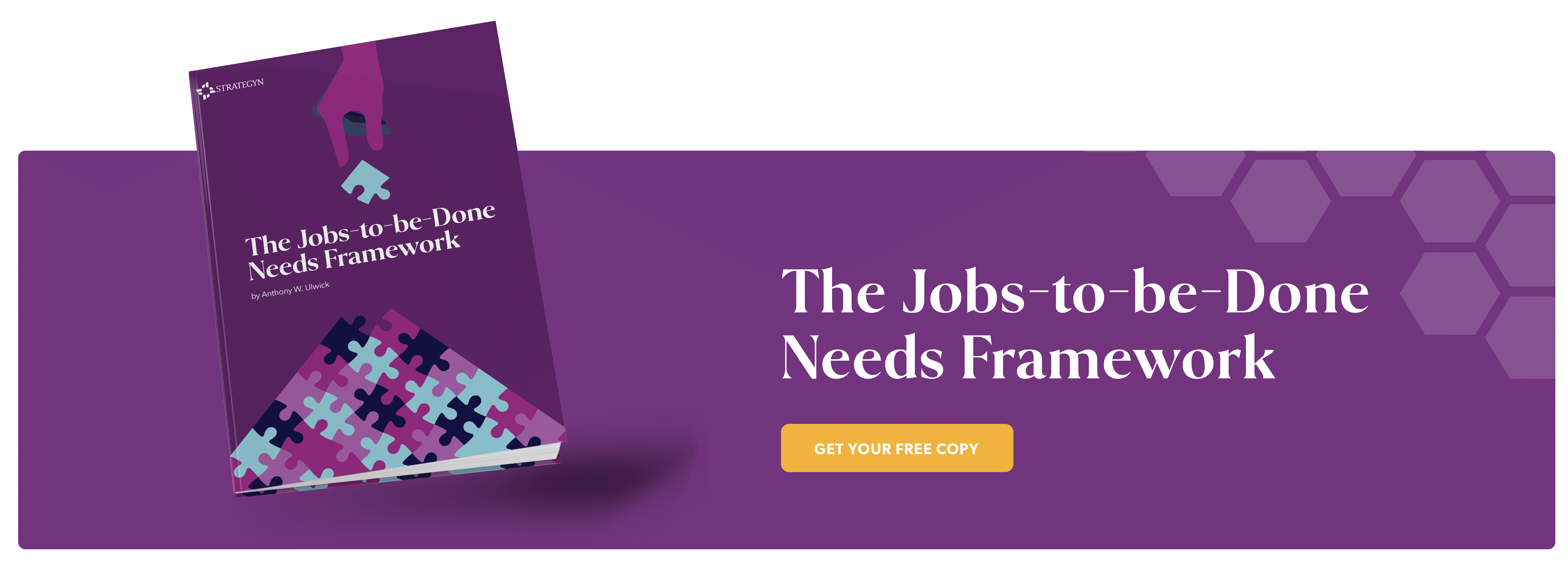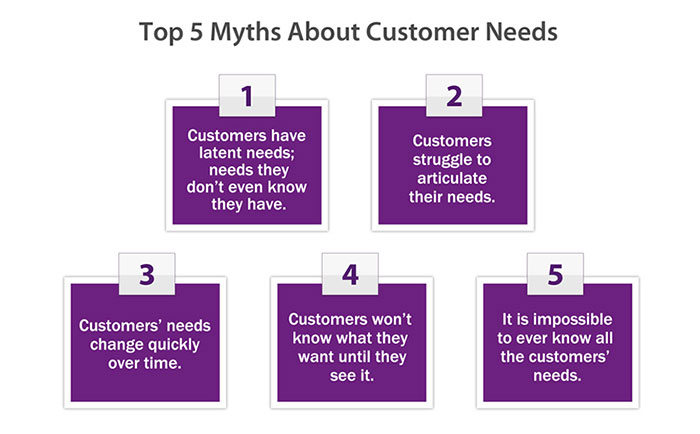Every company's success depends on its ability to create products and services that address unmet customer needs. Despite this fact, in over 95 percent of all companies, marketing and development managers don't agree on what a customer “need” even is.
More specifically, they disagree on what characteristics a customer need statement should possess, what information it should contain, its purpose, and how it should be structured. The first step in becoming a customer-centric organization is agreeing on a customer needs definition.

Over the past two decades, we have worked to overcome this fundamental problem by inventing the “perfect” customer need statement. Our work is grounded in the fundamental belief that people buy products and services to get a “job” done.
Looking at markets through a jobs-to-be-done lens, we've discovered that a customer need is best defined as a statement that describes how a customer measures success and value when getting a job done. We call these statements “desired outcomes.”
The desired outcome statement is uniquely structured to detail how customers define value and how a company can help create it. It unearths the metrics used by loyal customers to measure success when getting the job done. These statements, often totaling more than 100 for a given job, describe the precise dimensions along which customers potentially seek to get the job done better.
Take the job of listening to music, for example. Consumers tell us that they seek to (1) minimize the time it takes to find desired songs, (2) minimize the likelihood of choosing unwanted versions of a song, and (3) minimize the time it takes to change the order in which songs are heard.
These customer needs examples are measures of customer value, actionable and controllable through product design, predictive of success, independent of a solution or technology, and stable over time.
These are characteristics that “perfect” customer need statements should possess. They are the valuable insights that enable customer-centric companies to align themselves around creating customer value and influencing a customer's purchase decision.
These unique customer inputs form the foundation for our innovation process, Outcome-Driven Innovation (ODI). Learn more about customer desired outcomes in the MIT Sloan article authored by Tony Ulwick, Giving Customers a Fair Hearing.
Nearly every company's managers and customer service teams hold some of these mistaken beliefs about identifying their target audience's needs. These beliefs are a key reason why companies struggle to develop innovative ways of meeting customer needs and maintaining loyalty.
These myths have survived for decades because companies commonly confuse customer needs with solutions. The critical point is that a customer needs analysis is not a solution, product feature, or idea. The truth is customers don't know what solutions will help them do their job well, nor should they.
Customers are not engineers, scientists, and materials experts. It's up to the company to come up with the best solutions once they identify customer needs or desired outcomes, are known.
If you still believe that any of these myths is true, it is because you falsely assume a need can be a solution. This product-centric mindset is why traditional methods for identifying customer needs don't work, and these myths seemingly explain why.

Customer needs fall under different categories. However, the main categories include functional, emotional, and social.
Functional needs evaluate whether the product can achieve the desired function or task. For instance, a customer may say, "I need a new phone for my upcoming vacation. " A deeper insight into the customer needs may push the company to develop a new product with waterproof capability, an excellent camera, and prolonged battery life.
Social needs vary from customer to customer and considerably influence their final decision to purchase. Understanding your customer's social needs may determine your product development, marketing, and sales strategies. For instance, if the customer is a member of a fancy club, they may be influenced to purchase a phone with the latest and most advanced features.
Emotional needs cater to how a customer feels after using the product. They invoke certain emotions that the customer looks for in a product. If the customer finds taking photos a relaxing hobby, a phone with an ultra-wide camera and substantial optical zoom may be their preferred option.
Steve Jobs said, “You've got to start with the customer experience and work backward to the technology. You cannot start with the technology and try to figure out where you will sell it.” Our outcome-driven approach to innovation enables companies to do precisely that. Understanding customer needs before developing solutions is the hallmark of the ODI process.
ODI has its roots in six-sigma thinking, where manufacturing engineers measure and control specific metrics to ensure a predictable process output.
When applying this thinking to innovation, the goal is to understand the metrics your target customers use to measure success when getting a job done and to create products and services that help them get the job done faster, more predictably, and with higher efficiency or throughput.
With a complete set of desired outcomes in hand, a company, through its customer service team, can evaluate a proposed solution to determine just how much better it will address the metrics and get the job done.
Using this approach, companies can quantify the potential value of a proposed solution, thus making it possible to predict what ideas will succeed in the marketplace in advance of the development process.
Customers do not naturally share the metrics they use to measure success when getting a job done. Consequently, customers must engage in a conversation designed to extract these desired outcome statements from them.
The process begins by defining the job-to-be-done and the job map. The approach we use to gain these insights is the subject of one of Harvard Business Review's most popular articles on innovation, The Customer-Centered Innovation Map, authored by Strategyn's founder Tony Ulwick.
Trained interviewers can extract desired outcome statements from soliciting customer feedback in nearly any customer setting, including market research, customer surveys, customer journey mapping, focus groups, personal interviews, group interviews, and ethnographic or anthropological research.
In a typical one-hour interview, it is possible to capture between twenty and thirty desired outcomes from a single customer. The captured outcomes (totaling between 50 and 150 statements from valuable customer data) collectively represent the performance measures that define the successful execution of a specific job.
Having a full customer needs analysis defined around the job-to-be-done impacts all aspects of innovation, including the way opportunities are defined, the way markets are segmented and sized, the way product and pricing strategies are formulated, and the way ideas are constructed, tested, and positioned. Desired outcomes statements guide and drive the entire innovation process.
For instance, if the customer needs analysis points at a broader range of product preferences, the company may innovate different sizes and colors for the specific product. On the other hand, they may strategize on producing affordable products to satisfy price customers who feel the product is priced way higher than the competitor.
Learn more about customer needs analysis and why latent needs are a myth.
The Customer-Centered Innovation Map
In this groundbreaking 2008 Harvard Business Review article, Tony Ulwick and Lance Bettencourt reveal an important discovery they made while turning jobs-to-be-done innovation theory into practice: job mapping. A job map breaks down the job the customer is trying to get done in a way that enables us to discover all the customer’s needs.
Learn More
Giving Customers a Fair Hearing
In this provocative article in the MIT Sloan Management Review, Tony Ulwick and Lance Bettencourt reveal how a customer need must be defined within the jobs-to-be-done framework to become a useful input into the innovation process. This article explains the different types of customer needs and how we use them to create customer value.
Download the article
Debunking Myths about Customer Needs
In this thoughtful article published by the American Marketing Association, Lance Bettencourt discusses the five myths surrounding customer needs that undermine innovation. He refutes each myth and outlines why they are a negative influence.
Download the article
Silence the Voice of the Customer
This white paper by Strategyn founder Tony Ulwick highlights the business advantages of our ODI methods for capturing and prioritizing customer needs. It explains why traditional voice-of-the-customer (VOC) practices continue to fail and makes a solid case for retiring VOC as a method for understanding customer needs.
Download the white paper
Retiring the House of Quality
Quality Function Deployment (QFD) was created as a tool for product design, not as a tool for innovation. When used to identifying customer needs, this useful design tool fails to produce effective results. This article by Strategyn’s Tony Ulwick and Rick Norman and Richard Zultner of the QFD Institute makes a case for retiring the House of Quality as an innovation tool.
Download the white paper
What is Outcome-Driven Innovation
This white paper by Strategyn founder and ODI inventor Tony Ulwick explains why innovation has historically been an ineffective process, the discoveries he made that led to ODI, and how defining needs through a jobs-to-be-done lens changes the way the entire innovation process is executed.
Download the white paper
What Customers Want
What Customers Want, the best seller by innovation thought leader Tony Ulwick, explains what Outcome-Driven Innovation (ODI) is and why it works. Ulwick, who pioneered jobs-to-be-done thinking and invented ODI, details how ODI transforms jobs-to-be-done theory into a practical method for understanding customer needs and an effective process for innovation and growth.
Learn More
Choose from a dozen case studies with companies such as Microsoft, Ingersoll Rand, Bosch, and others, and learn how we have used our ODI methodology to understand customer needs in a variety of markets and used those inputs to help companies grow. Learn More
Copyright ©2024 Strategyn LLC. All Rights Reserved. | XML Sitemap | HTML Sitemap